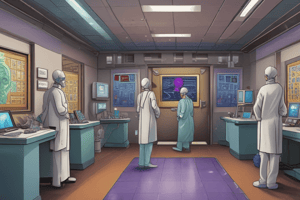Podcast
Questions and Answers
What is the major role of nuclear medicine in the management of malignant tumors?
What is the major role of nuclear medicine in the management of malignant tumors?
- Detection of benign tumors
- Treatment of infectious diseases
- Diagnosis of cardiovascular diseases
- Detection, staging, and restaging of malignant tumors (correct)
What is the purpose of sentinel node identification and localization in nuclear medicine?
What is the purpose of sentinel node identification and localization in nuclear medicine?
- To diagnose benign tumors
- To evaluate the response to therapy
- To detect residual or recurrent disease
- To plan the most suitable management for several tumors (correct)
What is the function of 99mTc - Octreotide in nuclear medicine?
What is the function of 99mTc - Octreotide in nuclear medicine?
- Detection of malignant tumors
- Evaluation of the response to therapy
- Specific agent for tumor imaging (correct)
- Radiotherapy planning
What is the purpose of 67Ga in nuclear medicine?
What is the purpose of 67Ga in nuclear medicine?
What is the role of nuclear medicine in the management of malignant tumors?
What is the role of nuclear medicine in the management of malignant tumors?
What is the purpose of 18F-FDG in nuclear medicine?
What is the purpose of 18F-FDG in nuclear medicine?
What is the role of nuclear medicine in tumor management?
What is the role of nuclear medicine in tumor management?
What is the purpose of 99mTc - Sestamibi in nuclear medicine?
What is the purpose of 99mTc - Sestamibi in nuclear medicine?
What is the primary challenge in using MRI and CT scans after surgical, radiation, or chemotherapy treatment?
What is the primary challenge in using MRI and CT scans after surgical, radiation, or chemotherapy treatment?
What is the role of radiopharmaceuticals in different malignancies?
What is the role of radiopharmaceuticals in different malignancies?
What is the benefit of using PET scans in detecting tumor recurrence?
What is the benefit of using PET scans in detecting tumor recurrence?
What is the purpose of using F-18-FDG-PET/CT studies?
What is the purpose of using F-18-FDG-PET/CT studies?
What is the limitation of MRI and CT scans in differentiating post-therapy changes?
What is the limitation of MRI and CT scans in differentiating post-therapy changes?
What is the role of thallium-201 in detecting tumor recurrence?
What is the role of thallium-201 in detecting tumor recurrence?
What is the benefit of using radiopharmaceuticals in cancer treatment?
What is the benefit of using radiopharmaceuticals in cancer treatment?
What is the purpose of evaluating response to therapy?
What is the purpose of evaluating response to therapy?
What is the main challenge in individualizing therapy for patients?
What is the main challenge in individualizing therapy for patients?
What is the primary goal of individualizing therapy?
What is the primary goal of individualizing therapy?
What is the limitation of using tumor volume changes to evaluate response to therapy?
What is the limitation of using tumor volume changes to evaluate response to therapy?
Which radiopharmaceutical agent is used to predict response to treatment in lymphoma?
Which radiopharmaceutical agent is used to predict response to treatment in lymphoma?
How soon can radiopharmaceutical agents like FDG and Gallium predict response to treatment?
How soon can radiopharmaceutical agents like FDG and Gallium predict response to treatment?
What is the advantage of using radiopharmaceutical agents like FDG and Gallium to evaluate response to therapy?
What is the advantage of using radiopharmaceutical agents like FDG and Gallium to evaluate response to therapy?
What is the purpose of a Ga-67 study in a patient with non-Hodgkin's lymphoma?
What is the purpose of a Ga-67 study in a patient with non-Hodgkin's lymphoma?
Why is it important to rapidly assess the effectiveness of a chosen treatment strategy?
Why is it important to rapidly assess the effectiveness of a chosen treatment strategy?
What is the purpose of sentinel node imaging?
What is the purpose of sentinel node imaging?
What is the role of a gamma probe during surgery?
What is the role of a gamma probe during surgery?
What does a follow-up FDG-PET study showing decreased uptake indicate?
What does a follow-up FDG-PET study showing decreased uptake indicate?
What is the next step after sentinel node localization?
What is the next step after sentinel node localization?
What type of cancer is shown in figure 26?
What type of cancer is shown in figure 26?
What is the purpose of immunohistological staining?
What is the purpose of immunohistological staining?
What is used to detect radioactive sentinel nodes?
What is used to detect radioactive sentinel nodes?
What can be identified using sentinel node imaging?
What can be identified using sentinel node imaging?
What is the acceptable alternative to routine total node dissection in breast cancer?
What is the acceptable alternative to routine total node dissection in breast cancer?
What is PET/CT used for in oncology?
What is PET/CT used for in oncology?
What is the role of PET and PET/CT in surgical management of breast cancer?
What is the role of PET and PET/CT in surgical management of breast cancer?
What is the title of the book edited by Elgazzar AH?
What is the title of the book edited by Elgazzar AH?
Which of the following is NOT a use of PET/CT in oncology?
Which of the following is NOT a use of PET/CT in oncology?
What is the title of the review by Bahl S, Alavi A, Basu S, Czerniecki BJ?
What is the title of the review by Bahl S, Alavi A, Basu S, Czerniecki BJ?
Who edited the book 'Pathophysiologic basis of nuclear medicine'?
Who edited the book 'Pathophysiologic basis of nuclear medicine'?
What is the title of the article by Francis IR, Brown RKJ, Avram AM?
What is the title of the article by Francis IR, Brown RKJ, Avram AM?
Flashcards are hidden until you start studying
Study Notes
Nuclear Medicine in Oncology
- Nuclear medicine plays a vital role in managing malignant tumors, incorporating advancements in molecular imaging and imaging equipment.
- It aids in the detection, staging, restaging, and early detection of recurrence in malignant diseases, as well as evaluating therapy response and predicting prognosis.
- Important applications include the identification and localization of sentinel lymph nodes for biopsy, enhancing management strategies for various tumors.
Radiopharmaceuticals for Tumor Imaging
- Nonspecific agents:
- 67Gallium (67Ga)
- 201Thallium (201Tl)
- 99mTechnetium (99mTc) - MDP
- Specific agents:
- 131I /123I
- 111Indium (111In)
- 99mTc-Octreotide
- 99mTc-Sestamibi
- 18F-Fluorodeoxyglucose (FDG)
Diagnosis of Tumors
- Nuclear medicine is effective for detecting and characterizing tumors, particularly in differentiating post-therapy changes from viable tumor tissue.
- Imaging helps identify viable tumors, addressing difficulties faced by MRI and CT scans in patients post-treatment.
- PET imaging enhances detection of tumor recurrence and differentiates between necrosis and actual tumor recurrence.
Residual or Recurrent Disease Detection
- Imaging, such as F-18-FDG-PET/CT, provides baseline and follow-up studies to detect recurrent tumors, exemplified by its use in cases like Hodgkin’s lymphoma.
Evaluating Response to Therapy
- Patient responses to treatment can vary, emphasizing the need for personalized therapy approaches.
- Rapid assessment of therapy effectiveness is crucial due to heterogeneity in tumors and hosts.
- Traditional tumor volume assessment through CT or MRI takes longer, potentially delaying treatment adjustments.
- Radiopharmaceuticals like Ga-67 in lymphoma and FDG in various cancers assess treatment responses as early as after 1-3 cycles of chemotherapy.
Sentinel Lymph Node Localization
- Sentinel node imaging identifies lymph nodes draining the primary tumor, assisting in surgical planning.
- This technique is the preferable alternative to total node dissection in breast cancer management.
- Immunohistological staining of sentinel nodes helps identify micrometastases, enabling more targeted treatment options.
Summary of Advantages
- Nuclear medicine enhances detection and characterization of tumors, while also facilitating individualized therapy through real-time assessment.
- It provides critical insights into tumor behavior and therapy effectiveness, thus improving overall cancer management strategies.
Studying That Suits You
Use AI to generate personalized quizzes and flashcards to suit your learning preferences.




